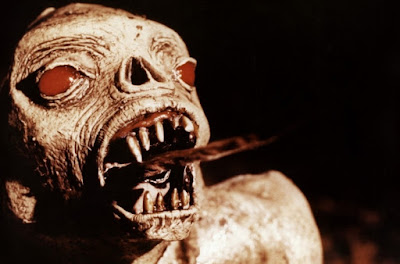“Is that Davina?” “Sort of.” Davina McCall as Davina McCall
in Charlie Brooker’s zombie masterpiece.
TOWARDS the end of the first episode of E4's astonishing DEAD SET, the camera pans to a crouching figure in Channel 4's BIG BROTHER offices, savagely tearing at the entrails of a newly-slaughtered production assistant. It is the actions of an undead Davina McCall. Looking up - her face smeared with blood and innards - she then lunges for her whimpering producer, howling with bestial blood lust, as she chases him down a corridor. Screened over five consecutive evenings culminating on Halloween, DEAD SET follows in real-time the staff and "stars" of BIG BROTHER during a zombie outbreak, which starts on Eviction Night.
In George A. Romero's seminal DAWN OF THE DEAD, a group of mismatched survivors take refuge in a deserted shopping mall - then a thinly veiled nod to consumerist Western society. Thirty years later - with the mall replaced by the BIG BROTHER house - this mini-series is ripe for 21st Century allegories, an extremely visceral satire of the morally bankrupt Reality-TV generation. Like all lasting zombie pieces, DEAD SET therefore resonates truly in its time and - like all great art - is born out of disdain. This impact can be traced back to the birth of the cinematic living dead - WHITE ZOMBIE. Film historians have always equated the boom in 1930s horror to the aftermath of the Wall Street Crash, though WHITE ZOMBIE can be related more to the human condition than Dracula or Frankenstein. Expressing the powerlessness breadline Americans felt - unemployed almost reached 25% at the height of the depression - the film transformed work itself into the horror. The zombies who operate the sugar mill are humans reduced to expendable automatons; even when one worker plummets into the machinery they continue unabated, a pivotal moment that laid bare the wheels of capitalist economics.
Even the Diary Room can’t save Jaime Winstone as Kelly, the
much put-upon production runner turned feisty heroine.
much put-upon production runner turned feisty heroine.
Critical preconceptions about horror - one that it shares with science fiction - is that by introducing elements of fantasy, a work becomes less likely to explore social and emotional issues and instead concern itself with escapism. But it can be argued that the inclusion of fantasy opens up a new, free arena in which greater extremes of the human condition can be put under the microscope. Romero's NIGHT OF THE LIVING DEAD explores the impossibility of an undead uprising, but is less interested by the dead in narrative terms than by the pressure-cooker situation they create for the characters. Zombies are simply enemies, a malignant obstacle that our heroes have to overcome. The end of life itself is a universal fear, one that comes without cultural or historical baggage.
This reading shouldn't detract from DEAD SET being a stunning slab of television horror. Maybe it shouldn’t be surprising that writer Charlie Brooker has admitted to a lifelong affinity to the living dead. After all, he has made his acerbic career critiquing years of life-less fodder that passes as modern TV entertainment. Production manager Patrick (Andy Nyman) is a priceless character who acts as a mouthpiece for Brooker and the millions of views who scream despondently at BIG BROTHER contestants ("…is the whole world just colours and shapes and the occasional noise in your head.") Brooker’s zombies belong to the sprinting, adrenaline-flesh junkie brand of 28 DAYS LATER… rather than Romero’s grey-skinned walkers, but new here is an unnerving death rattle as they stalk and feed. The gore quota - especially in the last two episodes - is astounding; one can only think of the final reel of Romero’s own DAY OF THE DEAD to rival its level of grue. Yet the tone of the series is sombre but slick.
This reading shouldn't detract from DEAD SET being a stunning slab of television horror. Maybe it shouldn’t be surprising that writer Charlie Brooker has admitted to a lifelong affinity to the living dead. After all, he has made his acerbic career critiquing years of life-less fodder that passes as modern TV entertainment. Production manager Patrick (Andy Nyman) is a priceless character who acts as a mouthpiece for Brooker and the millions of views who scream despondently at BIG BROTHER contestants ("…is the whole world just colours and shapes and the occasional noise in your head.") Brooker’s zombies belong to the sprinting, adrenaline-flesh junkie brand of 28 DAYS LATER… rather than Romero’s grey-skinned walkers, but new here is an unnerving death rattle as they stalk and feed. The gore quota - especially in the last two episodes - is astounding; one can only think of the final reel of Romero’s own DAY OF THE DEAD to rival its level of grue. Yet the tone of the series is sombre but slick.

































